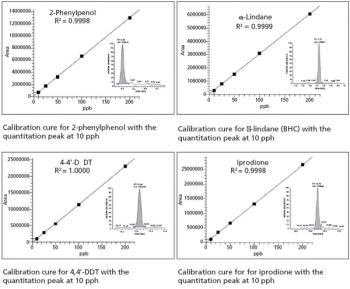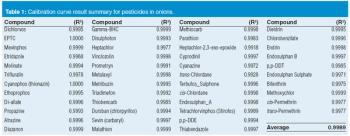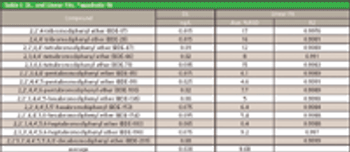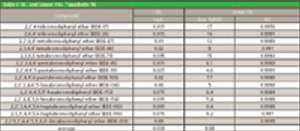
International regulations on maximum residue levels (MRLs) of pesticides in food cover hundreds of individual contaminants at the 10 ppb or below range. The analysis of citrus oil for pesticide contamination holds specific challenges.
Thermo Fisher Scientific, Austin, Texas

International regulations on maximum residue levels (MRLs) of pesticides in food cover hundreds of individual contaminants at the 10 ppb or below range. The analysis of citrus oil for pesticide contamination holds specific challenges.

Most recently formulated pesticides are smaller in molecular weight and designed to break down rapidly in the environment.

Polybrominated diphenyl ethers (PBDEs) are bioaccumulativetoxic compounds that are used as flame retardants. They have high boiling points and low thermal stability which makes analysis by GC–MS challenging. Additional bromines increase the thermal instability. A method was developed to analyze for polybrominated biphenyls using a large volume injection, short analytical column, and high mass tuning algorithm on the Thermo Scientific DSQ II with detection by EI Single Ion Monitoring (SIM).


Use of a modified QuEChERS sample preparation procedure was fully evaluated for identification and quantitation of pesticides in lettuce using gas chromatography and ion trap mass spectrometry. Final results compared favorably to the reporting and detection limits offered by several worldwide agencies, demonstrating a robust and reliable solution for analyzing pesticide residues in lettuce.


Negative chemical ionization GC-MS, used in conjunction with automated cold-on-column injection, provides efficient and sensitive quantification of explosive residues for environmental and forensic applications.

Published: June 1st 2011 | Updated:

Published: December 2nd 2009 | Updated:

Published: June 1st 2009 | Updated:

Published: March 30th 2007 | Updated:

Published: February 1st 2009 | Updated:

Published: February 1st 2008 | Updated: